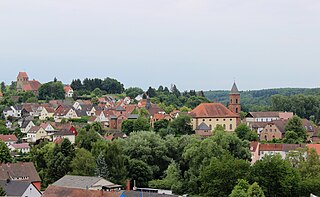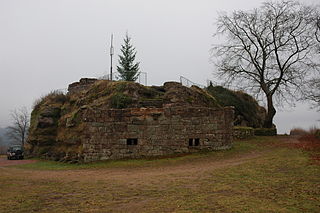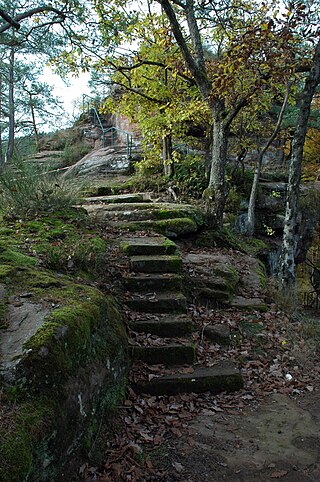
Pirmasens is an independent town in Rhineland-Palatinate, Germany, near the border with France. It was famous for the manufacture of shoes. The surrounding rural district was called Landkreis Pirmasens from 1818 until 1997, when it was renamed to Südwestpfalz.

Otterberg is a town in the district of Kaiserslautern in the German state of Rhineland-Palatinate with about 7,350 inhabitants. It is situated approximately 7 kilometres (4 mi) north of Kaiserslautern.

Saint Pirmin, was a Merovingian-era monk and missionary. He founded or restored numerous monasteries in Alemannia (Swabia), especially in the Alsace, along the Upper Rhine and in the Lake Constance region.

Glan-Münchweiler is an Ortsgemeinde – a municipality belonging to a Verbandsgemeinde, a kind of collective municipality – in the Kusel district in Rhineland-Palatinate, Germany. It belongs to the Verbandsgemeinde of Oberes Glantal.

Hornbach is a town in the Südwestpfalz district, in Rhineland-Palatinate, Germany. It is situated southwest of the Palatinate forest, on the border with France, south of Zweibrücken. It is part of the Verbandsgemeinde Zweibrücken-Land.

Breitenbach is an Ortsgemeinde – a municipality belonging to a Verbandsgemeinde, a kind of collective municipality – in the Kusel district in Rhineland-Palatinate, Germany. It belongs to the Verbandsgemeinde of Oberes Glantal. Breitenbach is one of the Kusel district's eight biggest municipalities. It is also the Palatinate's westernmost municipality.

Gries is an Ortsgemeinde – a municipality belonging to a Verbandsgemeinde, a kind of collective municipality – in the Kusel district in Rhineland-Palatinate, Germany. It belongs to the Verbandsgemeinde of Oberes Glantal, whose seat is in Schönenberg-Kübelberg.

Henschtal is an Ortsgemeinde – a municipality belonging to a Verbandsgemeinde, a kind of collective municipality – in the Kusel district in Rhineland-Palatinate, Germany. It belongs to the Verbandsgemeinde of Oberes Glantal.

Eimsheim is a winegrowing Ortsgemeinde – a municipality belonging to a Verbandsgemeinde, a kind of collective municipality – in the Mainz-Bingen district in Rhineland-Palatinate, Germany.

Joseph Charles, Hereditary Prince of Sulzbach was the eldest son of Theodore Eustace, Count Palatine of Sulzbach.

Limburg Abbey is a ruined abbey near Bad Dürkheim, at the edge of the Palatinate Forest in Germany. In the 9th century, the Salian Dukes from Worms built a fortress on the Linthberg as their family seat.

Frankenstein Castle is a medieval fortification on a spur above the village of Frankenstein, Rhineland-Palatinate in the Palatinate Forest in Germany. Its name derives from the local House of Frankenstein.

The Palatine Ways of St. James are those sections of the Way of St. James in the Palatinate region of Germany and part of the historic pilgrimage route to the northwest Spanish town of Santiago de Compostela. It was there that, according to Christian tradition, the Apostle Saint James the Greater was buried.

The Westrich Plateau, also Zweibrücken Westrich or Southwest Palatine Plateau, is a landscape in the German state of Rhineland-Palatinate, with small areas also in the Saarland (Saarpfalz-Kreis). Its heart is in the southwest of the Palatinate region and it is part of the historic region of Westrich.

Weissemburg Abbey, also Wissembourg Abbey, is a former Benedictine abbey in Wissembourg in Alsace, France.

Lemberg Castle is a medieval castle on the territory of Lemberg in the county of Südwestpfalz in the German state of Rhineland-Palatinate.

The Wilgartaburg, also called the Wiligartaburg, Wilgartsburg or Wiligartisburg, is the heritage site of a ruined rock castle located at a height of 245 m above sea level (NN) near the German village of Wilgartswiesen in the state of Rhineland-Palatinate.

The Palatine Higher Regional Court in Zweibrücken is one of two Higher Regional Courts in the German state of Rhineland-Palatinate, along with the Higher Regional Court in Koblenz.

Stauf Castle is a ruined spur castle near the village of Stauf in the borough of Eisenberg in the county of Donnersbergkreis in the German state of Rhineland-Palatinate.
The text of this article is based on a translation of the German language article, Johannes I

























